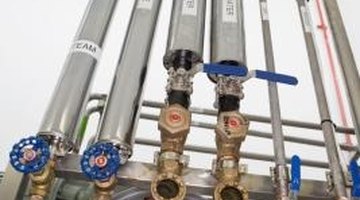How to Install a Dielectric Nipple
Dielectric nipples are used to connect to dissimilar metals. Municipal, state and federal plumbing codes often prohibit the use of non-dielectric unions and nipples because galvanization occurs between dissimilar metals at a rate much greater than that which occurs between two unlike metals joined by a dielectric nipple or union. Galvanization creates leaks. A dielectric nipple prevents electrolysis, which occurs between opposing metals when an electrolyte -- water for example -- is introduced as a conductor. Plastic is a good non-conductive connector that prevents galvanization. Dielectric nipples contain a plastic lining within that acts as a non-conductor.

-
Teflon tape the threads at each end of the nipple. Wrap the tape counter clockwise. If you wrap it clockwise, it unwraps and bunches when you thread the nipple into the female adapter of the pipe.
-
Thread the nipple into one of the pipes by hand. Screw the nipple in as far as you can, careful not to cross thread the nipple into the pipe. Tighten the nipple with the pipe wrench, twisting clockwise.
-
Thread the female end of the opposing pipe onto the nipple by hand. Again, careful not to cross thread the nipple. Put one pipe wrench over the center of the nipple. Place the second over the female end of the pipe. Hold the wrench on the nipple stationary as you turn the pipe clockwise. Tighten the pipe onto the nipple as much as possible with one hand.
Photo Credits
- Jupiterimages/Comstock/Getty Images
More Articles



